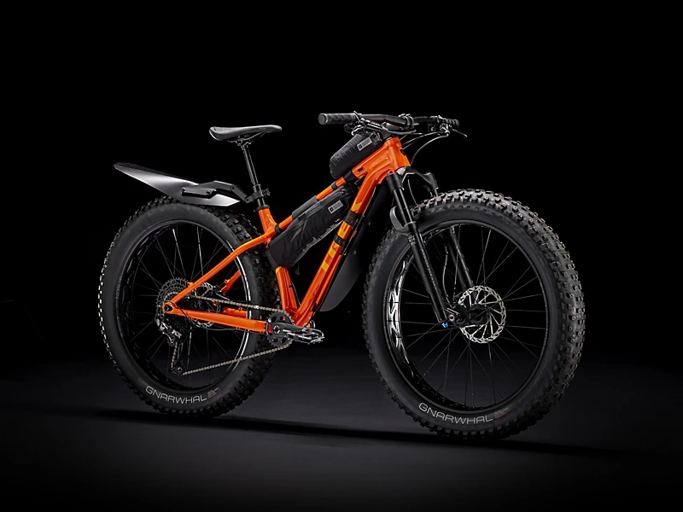If you’re considering a fat bike, there are a few disadvantages you should be aware of. Fat bikes are heavier and more difficult to pedal than traditional bikes, and they’re not well suited for long-distance riding. They’re also more expensive, and their wide tires can make them difficult to maneuver on tight trails.
1. Fat Bikes Can Be Expensive
The average fat bike costs around $1,500, which is significantly more than a regular mountain bike. If you’re looking for a new bike and are considering a fat bike, you should be aware that they can be expensive. If you’re on a budget, a fat bike may not be the best option for you.
2. Fat Bikes Can Be Slower
However, fat bikes can be a great option for leisurely rides or for taking on more challenging terrain. Fat bikes can be slower than other types of bikes, and they’re not always the best choice for racing or other high-speed activities. If you’re looking for a fast bike to take on the trails, a fat bike might not be the best option.
3. You are Restricted with Tire Options
This can be a hassle and an additional expense. If you’re looking to buy a fat bike, be aware that you are restricted with tire options. These tires are great for riding on snow, but they are not ideal for riding on other surfaces. If you want to ride on sand, for example, you’ll need to buy a different set of tires. Most fat bikes come with 26″ x 4.0″ or 27.5″ x 3.8″ tires.
4. Fat Bikes Can Cause Some Problems with Hips and Knees
If you’re considering a fat bike, there are a few disadvantages you should be aware of before making your purchase. The extra weight of the bike and the wide tires can put strain on these joints, which can lead to pain or even injury. One potential issue is that fat bikes can cause problems with hips and knees. If you have any existing issues with your hips or knees, it’s important to consult with a doctor or physical therapist before riding a fat bike. Even if you don’t have any existing problems, it’s still a good idea to warm up and stretch before and after riding to help prevent any future issues.
5. Fat Bikes Are Tougher to Transport Around
But that extra width makes them tougher to transport around, whether you’re loading them into a car or carrying them up stairs. If you’re looking for a workout and don’t mind a little extra effort when it comes to transportation, a fat bike might be the right choice for you. Fat bikes are designed for off-road riding, with wider tires that can handle rougher terrain. Here are a few things to keep in mind if you’re considering a fat bike.
6. You May Have Limited Frame Options
If you’re considering a fat bike, there are a few disadvantages you should be aware of. Fat bikes typically have only one or two frame size options, so if you’re looking for a specific size, you may be out of luck. Additionally, fat bikes can be more expensive than other types of bikes, and they may not be available at your local bike shop. One is that you may have limited frame options.
7. Fat Bikes Are Harder to Steer on Technical Terrain
If you’re looking for a workout and don’t mind a little extra effort, a fat bike might be for you. This can make for a more challenging ride, but it also means you’ll get a better workout. Fat bikes are harder to steer on technical terrain because of their wider tires. Just be prepared for a little extra effort when steering on tight turns or in rocky terrain.
8. Fat Bikes Are Heavy
A fat bike is a mountain bike with extra-wide tires designed for low ground pressure. The low pressure allows the bike to float over sand and snow. Fat bikes typically have four-inch-wide tires, which are about twice as wide as a standard mountain bike tire.

The extra width makes the bike heavier and slower, which are two of the main disadvantages of fat bikes. Fat bikes are also more expensive than standard mountain bikes.
9. Fat Bikes Have Fewer Gears
This can make it difficult to ride up hills and can also make pedaling less efficient. Additionally, fat bikes can be more difficult to maneuver and can be slower than other bikes. When it comes to fat bikes, one of the main disadvantages is that they have fewer gears.
10. You Won’t Really Develop the Technical Side of Riding
This is because fat bikes are designed for stability and traction, not for speed or maneuverability. One of the main disadvantages of fat bikes is that you won’t really develop the technical side of riding. As a result, you may find yourself relying on the bike’s features rather than your own skills.
11. You Need to Work at the Tire Pressure
One of the potential disadvantages of riding a fat bike is that you need to put more effort into maintaining the tire pressure. Fat bikes have tires that are significantly wider than traditional bike tires, which means that they require more air pressure to stay inflated. If you don’t keep an eye on the pressure and top off the tires as needed, you may find yourself with a flat tire on your next ride.
12. You Can’t Really Just Blend In On A Fat Bike!
In this section, we’re going to focus on one particular aspect – you can’t really just blend in on a fat bike! While this may seem like a disadvantage at first, we’ll show you how it can actually be a good thing. Whether you’re a newbie or a seasoned vet, there’s always something to learn when it comes to fat biking.
13. You May Feel You are Riding Uphill
And, because they have wider tires, they can create more resistance on the road. If you’re new to fat biking, you may feel like you’re constantly riding uphill. But, with a little practice, you’ll be able to ride your fat bike like a pro. Fat bikes are heavier than traditional bikes, so they can be more difficult to pedal.
14. They Have a Lot of Rolling Resistance
This can make it more difficult to pedal a bike, especially on hills. The higher the rolling resistance, the more force is required to keep the tire rolling. Rolling resistance is the force required to keep a tire rolling. It is caused by the deformation of the tire as it rolls and by the friction between the tire and the ground.

Fat bikes can be more difficult to pedal, especially on hills. Fat bikes have a lot of rolling resistance because of their large tires. The tires are designed to provide a lot of grip and floatation on soft surfaces like snow and sand. This comes at the expense of rolling resistance.
It’s something you’ll need to account for when riding, especially on hills. If you’re considering a fat bike, be aware of the increased rolling resistance.
15. Fat Bikes Have Slower Response Times
Second, the tires are wider and have less contact with the ground, which makes them less efficient at transferring power to the ground. First, they are heavier than other bikes, which makes them harder to accelerate. Finally, the gearing is often lower, which means that the bike has to work harder to maintain a given speed. Fat bikes have slower response times for a variety of reasons. Third, the suspension is generally softer, which absorbs more energy and reduces the bike’s ability to transfer power to the ground.
16. They are Almost Exclusively Muscle Powered
If you’re considering a fat bike, it’s important to be aware of the potential disadvantages. Here are 16 things to keep in mind before making your purchase.
1. Fat bikes are almost exclusively muscle powered.
2. They can be difficult to control on steep or technical terrain.
3. They’re not well suited for long distance riding.
4. They’re not particularly efficient on flat terrain.
5. They’re not particularly lightweights.
6. They’re not particularly nimble.
7. They can be difficult to transport.
8. They can be expensive.
9. They require more maintenance than other bikes.
10. They’re not well suited for beginners.
11. They’re not well suited for riders with limited mobility.
12. They’re not well suited for riders with back or neck problems.
13. They’re not well suited for riders with joint problems.
14. They’re not well suited for riders with balance problems.

15. They’re not well suited for riders with coordination problems.
16. They’re not well suited for riders with vision problems.
17. Fat Bikes Don’t Excel on Smooth Surfaces
If you’re looking for a bike that will give you a smooth ride on smooth surfaces, a fat bike is not the right choice. If you’re looking for a bike to ride on paved roads or bike paths, you’ll be better off with a road bike or a mountain bike. Fat bikes are designed for riding on rough terrain, and their wide tires make them less efficient on smooth surfaces.
Frequently Asked Questions
1. What are some of the disadvantages of fat bikes?
2. Are fat bikes less efficient than other bikes?
3. Do fat bikes require more maintenance?
4. Are fat bikes more difficult to ride?
5. Are fat bikes more expensive than other bikes?
1. Some of the disadvantages of fat bikes include their lower efficiency, higher maintenance requirements, and difficulty of riding.
2. Fat bikes are less efficient than other bikes because of their larger tires and heavier frame.
3. Fat bikes require more maintenance than other bikes because of their larger tires and heavier frame.
4. Fat bikes are more difficult to ride than other bikes because of their larger tires and heavier frame.
5. Fat bikes are more expensive than other bikes because of their larger tires and heavier frame.
Final thoughts
In conclusion, there are a few disadvantages to riding a fat bike that you should be aware of. They include the bikes being heavier and more difficult to transport, the tires being more expensive, and the bikes not being as efficient on paved surfaces. However, these disadvantages are outweighed by the many advantages of fat bikes, such as their ability to ride on all types of terrain, their increased stability and traction, and their ability to float over snow and sand.
